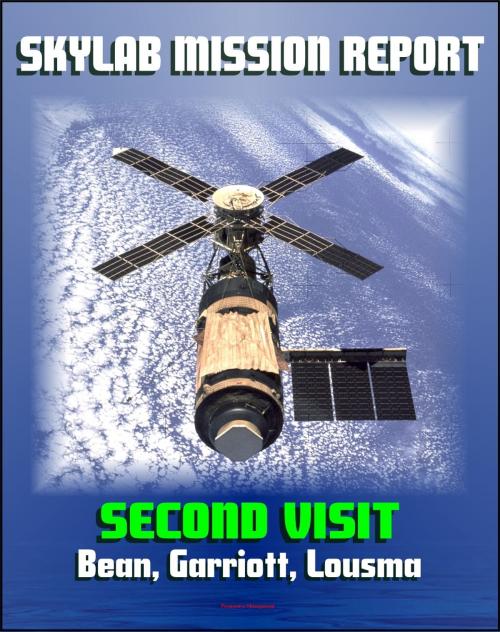Skylab Mission Report: Second Visit - 1973 Space Station Mission by Bean, Garriott, and Lousma, Mission Activities, Hardware, Anomalies, Science Experiments, Crew Health, EVAs
Nonfiction, Science & Nature, Technology, Aeronautics & Astronautics, Science, Physics, Astrophysics & Space Science| Author: | Progressive Management | ISBN: | 9781476295763 |
| Publisher: | Progressive Management | Publication: | May 18, 2012 |
| Imprint: | Smashwords Edition | Language: | English |
| Author: | Progressive Management |
| ISBN: | 9781476295763 |
| Publisher: | Progressive Management |
| Publication: | May 18, 2012 |
| Imprint: | Smashwords Edition |
| Language: | English |
This official NASA internal document - converted for accurate flowing-text ebook format reproduction - is a comprehensive evaluation of the operational and engineering aspects of the second manned visit to the Skylab space station and includes the performance of experiment hardware that is under Johnson Space Center management; the crew's evaluation of the visit; and other visit-related items of interest such as medical aspects and hardware anomalies.
The space vehicle, consisting of a modified Apollo command and service module payload on a Saturn IB launch vehicle, was inserted into a 231.3 by 154.7 kilometer orbit. Rendezvous maneuvers were performed during the first five orbits as planned. During the rendezvous, the command and service module reaction control system forward firing engine (quad B) oxidizer valve leaked. The quad was isolated. Stationkeeping with the Saturn Workshop began approximately 8 hours after lift-off with docking being performed about 30 minutes later.
The crewmen experienced motion sickness during the first three visit days. Consequently, the Saturn Workshop activation and experiment implementation activities were curtailed. By adjusting the crew's diet and maintaining a low work load, the crew was able to complete the adjustment to space flight in 5 days, after which the flight activities were returned to normal.
The first extravehicular activity was delayed to visit day 10 because of the crew's motion sickness. The extravehicular activity lasted almost 6.5 hours during which time the crew changed the Apollo Telescope Mount film, deployed the twin-pole sun shield, inspected and performed repair work on the S055 (Ultraviolet Spectrometer) experiment, deployed the S149 (Particle Collection) experiment, and installed the calibration shield from experiment S230 (Magnetospheric Particle Composition). A second extravehicular activity was performed on visit day 28 and lasted 4 hours and 30 minutes. A third extravehicular activity was accomplished on visit day 57 with a duration of 2 hours and 45 minutes to retrieve the expended film on the Apollo Telescope Mount solar experiments and experiments S230 and S149. Earth Resources Experiment Package activities included 39 passes with a total of 930 minutes of data. All experiment coverage was normal with the exception of the loss of experiment S193 (Microwave Radiometer/Scatterometer and Altimeter) when the antenna failed to operate during data pass 29. A series of medical experiments was accomplished which assessed the effect of a 59-day duration space mission on the crewmen. Included were a hematology and immunology program, a mineral balance assessment, an evaluation of the changes in hormonal and associated fluid and electrolyte parameters, the extent of bone mineral loss, the cardiovascular effects utilizing the lower body negative pressure experiment and the vectorcardiogram, and an assessment of the metabolic activity.
This official NASA internal document - converted for accurate flowing-text ebook format reproduction - is a comprehensive evaluation of the operational and engineering aspects of the second manned visit to the Skylab space station and includes the performance of experiment hardware that is under Johnson Space Center management; the crew's evaluation of the visit; and other visit-related items of interest such as medical aspects and hardware anomalies.
The space vehicle, consisting of a modified Apollo command and service module payload on a Saturn IB launch vehicle, was inserted into a 231.3 by 154.7 kilometer orbit. Rendezvous maneuvers were performed during the first five orbits as planned. During the rendezvous, the command and service module reaction control system forward firing engine (quad B) oxidizer valve leaked. The quad was isolated. Stationkeeping with the Saturn Workshop began approximately 8 hours after lift-off with docking being performed about 30 minutes later.
The crewmen experienced motion sickness during the first three visit days. Consequently, the Saturn Workshop activation and experiment implementation activities were curtailed. By adjusting the crew's diet and maintaining a low work load, the crew was able to complete the adjustment to space flight in 5 days, after which the flight activities were returned to normal.
The first extravehicular activity was delayed to visit day 10 because of the crew's motion sickness. The extravehicular activity lasted almost 6.5 hours during which time the crew changed the Apollo Telescope Mount film, deployed the twin-pole sun shield, inspected and performed repair work on the S055 (Ultraviolet Spectrometer) experiment, deployed the S149 (Particle Collection) experiment, and installed the calibration shield from experiment S230 (Magnetospheric Particle Composition). A second extravehicular activity was performed on visit day 28 and lasted 4 hours and 30 minutes. A third extravehicular activity was accomplished on visit day 57 with a duration of 2 hours and 45 minutes to retrieve the expended film on the Apollo Telescope Mount solar experiments and experiments S230 and S149. Earth Resources Experiment Package activities included 39 passes with a total of 930 minutes of data. All experiment coverage was normal with the exception of the loss of experiment S193 (Microwave Radiometer/Scatterometer and Altimeter) when the antenna failed to operate during data pass 29. A series of medical experiments was accomplished which assessed the effect of a 59-day duration space mission on the crewmen. Included were a hematology and immunology program, a mineral balance assessment, an evaluation of the changes in hormonal and associated fluid and electrolyte parameters, the extent of bone mineral loss, the cardiovascular effects utilizing the lower body negative pressure experiment and the vectorcardiogram, and an assessment of the metabolic activity.















